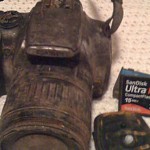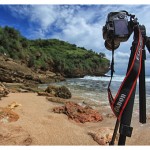
Some cameras have been manufactured to be impact, water, and dust resistant. But cameras of that caliber are not many and the prices are also expensive. It is advisable for owners of pocket camera/DSLR camera not classified as impact-resistant to treat their device with caution. But if impact occurs, there are a few suggestions users can follow to act as first aids.
The place and nature of impacts causes different affects on the camera units. There is of course a difference in severity for various places and conditions such as the camera falling on a mattress, a tiled floor, on dirt ground or into a body of water. Impacts with hard surfaces such as a tiled floor causes a higher risk of damaging the pocket camera/DSLR body and lens, which in return decreases the chance of survival of the device. On the other hand, dropping a camera into a body of water may not damage the outer shell of the camera, but may cause the camera to lose all its functionality.
The following are first aid procedures for when a camera unit comes into contact with different objects:
If Camerawas dropped on a Hard Surface:
The first step is to check the physical condition of the cameraafter the fall. Check for any dents, scratches, cracks, and detached parts. If fortunate, the camera would be in tact though with some shallow wounds.
– Check the condition of the lens. If the camera fell while in the OFF position, the camera body may have protected the lens because of its position being tucked inside the camera body(non-DSLR cameras). If it was in the ON position and the lens was fully extended, the lens may have suffered some damage. If the lens broke, then there’s not much else to do but to get it repaired at the nearest authorized service center.
– If the camera looks intact and the lens seems fine, the second step is to either check whether the camera is still active (if it was dropped in the ON condition); or check whether the camera can be activated (if dropped in the OFF condition). If the camera won’t activate after the fall, then immediately repair it at the nearest authorized service center.
– Thirds, if the camera can still be activated, check for any defects in the zoom mechanism when the lens is zoomed in and out. The impact may have caused the zoom to stall and the movement of the lens may seem irregular. If the lens seem bent, it may be possible to manually (with much caution) straighten the lens by hand. If successful, the lens may move normally again. If not, and the lens is tough to straighten by hand, take the camera device to the nearest authorized service center.
– Lastly, if the camera can be activated normally and the zoom also functions normally after the impact, try to photograph with the camera device and examine if there are any irregularity in its functions (the auto focus, for instance). Shoot several times and examine for any abnormality in the result.
If the Camera is dropped or submerged in water:
This may result in more severe effects. If the camera fell in water when it’s active, the camera is most likely permanently damaged.
– If the camera fell in the OFF position, immediately dry the camera unit and remove the battery and memory card.
– Try to shake any excess water off the camera unit. The probability is high that at this stage the electronic circuits inside have become wet, and the sensor and lens have also been exposed to water.
– Another first aid maneuver would be to keep the camera unit in a box along with silica gels or moisture absorbents for the duration of one week. This may help in absorbing any moisture in and on the camera. Drying the camera unit with a hair dryer may also help, but do not expect much results. When the unit is dry enough, with the battery still removed, immediately bring the camera to an authorized service center.
It’s not easy to save the damaged camera, and more likely than not the camera will have to be brought to an authorized service center. Also make note that these sorts of accidents cannot be claimed based on warranty because it’s classified as human error. So prevention is best. Use the camera carefully. And if planning on photographing in extreme conditions, it’s highly recommended to use waterproof, durable, dust resistant, and freeze resistant cameras.




